- Matching (Score)
- Our verdict
- Competing TVs
- TV appearance
- Where to buy
- Contrast and black detail
- HDR effect quality
- Factory color reproduction
- Color reproduction after calibration
- Smoothness of tonal transitions
- Image scaling and smoothness of tonal transitions
- Blur and motion smoothness
- Console compatibility and gaming features
- Input lag
- Compatibility with PC
- Viewing angles
- TV efficiency during daytime
- TV features
- Apps
- Playing files from USB
- Sound
- Details about the matrix
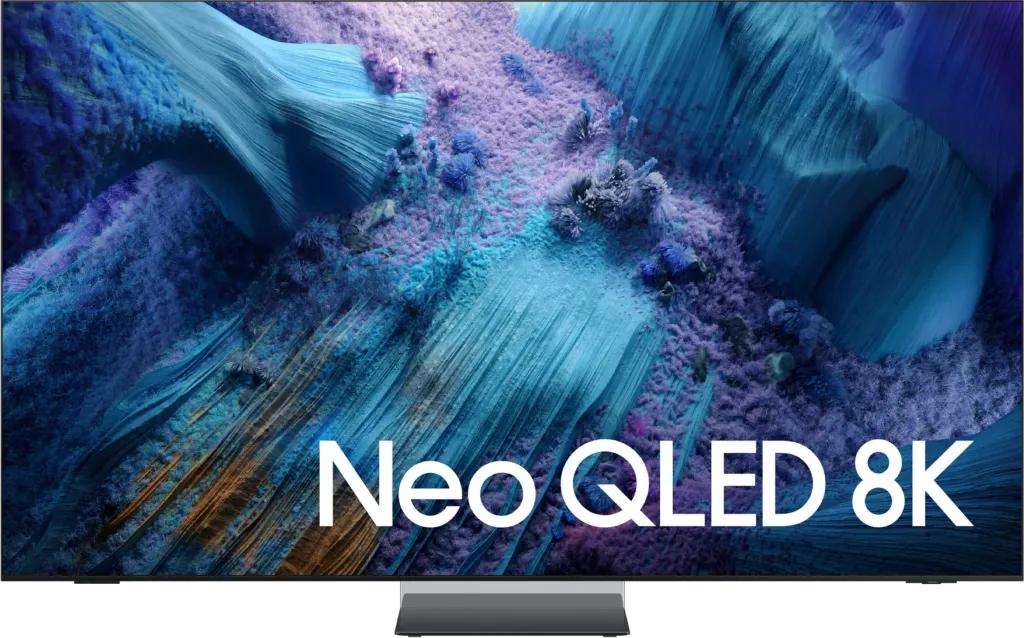
Complete the survey to find out the result
Panel type: LCD VA (wide viewing angle) Refresh rate: 240Hz Brand: SAMSUNG Resolution: 7680x4320 System: Tizen Model year: 2025
The Samsung QN990F is the absolute cream of the crop in the Koreans' offering for 2025. You don't have to look long for evidence – the price alone will leave you speechless, and in addition, we have several solutions that you won't find in any other television in the world. The wireless One Connect module, the first matte screen in an 8K television, and a design that can easily be called one of the best on the market. This is a television that immediately stands out from the competition. We decided to test it according to our testing procedures. Before you is the review of the world's first wireless 8K television!
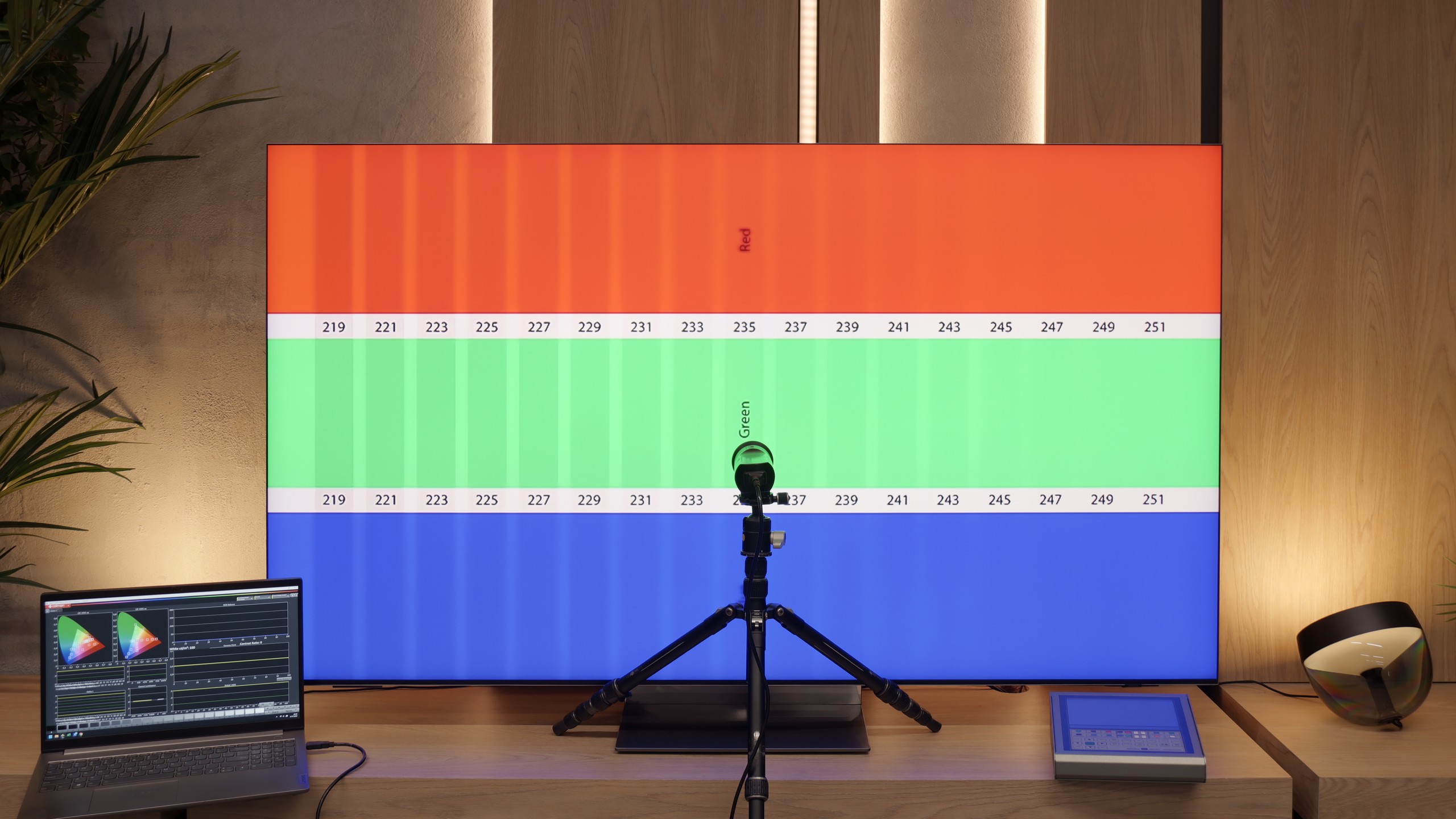
SAMSUNG QN990F - Our verdict
7.6
Overall rating
The Samsung QN990F is a television that makes a huge impression from the very first moment. It's probably one of the most attractive models on the market – ultra-slim, with an almost invisible frame and a base that gives the impression that the screen is levitating above the table. In addition, there's the futuristic Wiraless One Connect module, this time in a wireless version, which helps to reduce the number of cables in the living room and adds a modern character to the whole setup. But it doesn't end with the design. The QN990F also boasts powerful specifications. The Mini-LED with over a thousand dimming zones can generate contrast that at times rivals OLEDs. "Additionally, there is very high HDR brightness and a new matte panel that effectively eliminates reflections. And when we add great motion fluidity with a refresh rate reaching up to 240 Hz in 4K, we have a set of features that truly impress. Samsung hasn't forgotten about gamers either – we have Game Bar, VRR, ALLM, as well as five HDMI 2.1 ports and phenomenal input lag of 10–15 ms (when connected via micro HDMI).
And this is where we get to the crux of the matter. Because while the QN990F impresses on paper and in many tests, in practice some solutions still require refinement. The wireless One Connect module raises the input lag to unacceptable levels for gamers, the Mini-LED can struggle in difficult scenes with a lot of detail, and the lack of Dolby Vision or DTS:X serves as a reminder that Samsung is stubbornly forging its own path, sometimes at the expense of the user. Despite this, the QN990F is a television that indicates the direction of industry development. It is not a model for everyone – but for those who love gadgets, technological innovations, and want a screen in their living room that looks like it came from the future. However, if someone is looking exclusively for the best picture quality, even in Samsung's portfolio there are models that perform significantly better – perhaps without 8K, but with more refined contrast and colours. Because 8K still remains a technology that looks firmly to the future and the QN990F shows what televisions of tomorrow could look like. But are we – the viewers – already ready to pay such a high price for this vision and accept the compromises that come with it?
Advantages
Amazing Design
Wireless module Wiraless One Connect
Excellent black
High brightness
Matte display very effectively reduces reflections
Good viewing angles
The fastest TV in the world - refresh rate 4K@240Hz and 8K@120Hz excellent for sports
Many features for gamers: HDMI 2.1, VRR, ALLM, HGiG, Gamebar
Very fast and intuitive operating system Tizen OS
Disadvantages
Very high price
Local dimming algorithms could be improved
Lack of Dolby Vision and DTS:X
High input lag when wirelessly connected to Wiraless One Connect
Movies and series in UHD quality
7.7
Classic TV, YouTube
7.7
Sports broadcasts (TV and apps)
7.6
Gaming on console
9.2
TV as a computer monitor
7.9
Watching in bright light
5.2
Utility functions
7.5
Apps
8.7
Sound quality
7.9
Complete the survey to find out what fits your preferences
SAMSUNG QN990F - Competing TVs in this price range
SAMSUNG QN990F - TV appearance
HDMI inputs: 0 x HDMI 2.0, 5 x HDMI 2.1 (48Gbps) Outputs: Toslink (Optical audio), eARC (HDMI), ARC (HDMI) Network Interfaces: Wi-Fi 2.4GHz, Wi-Fi 5GHz, Ethernet (LAN) 100Mbps
Build quality: Super Premium
Stand type: Central
Kolor ramki: Silver


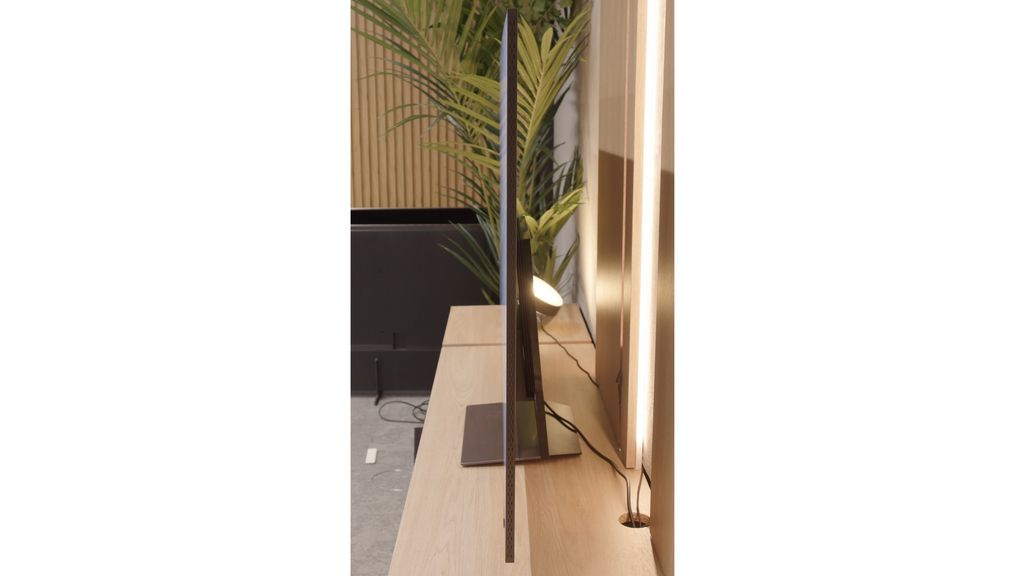

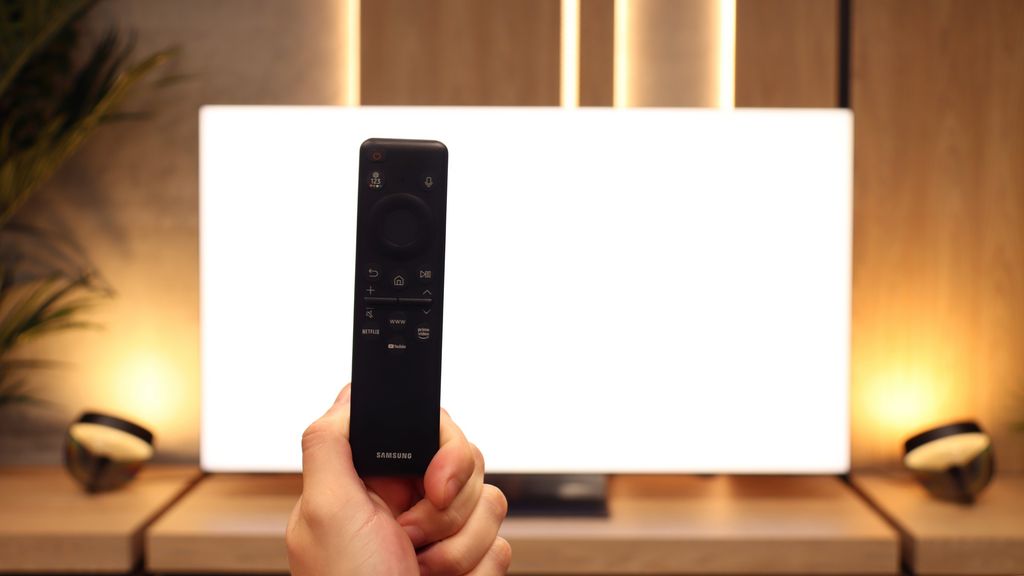
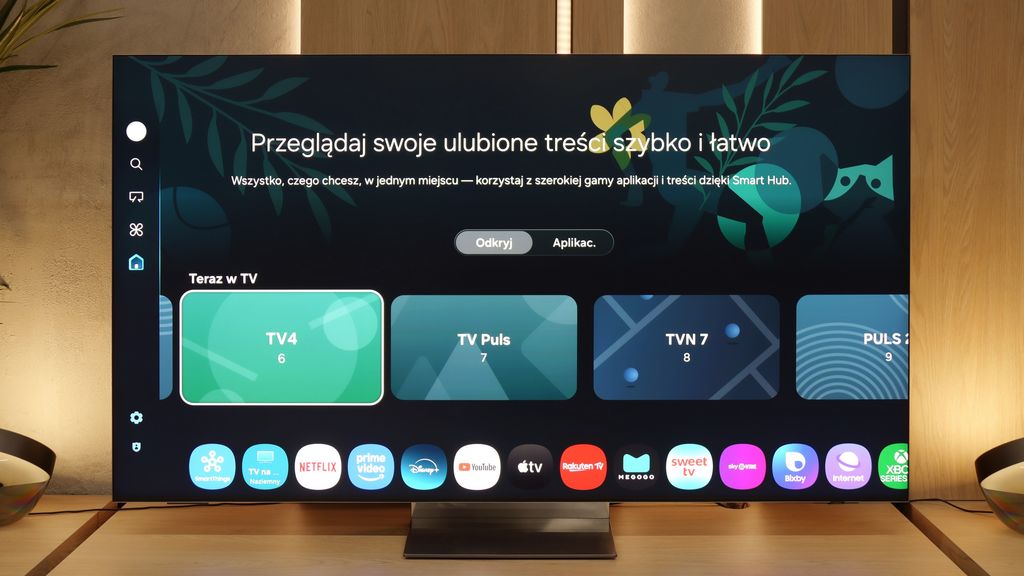
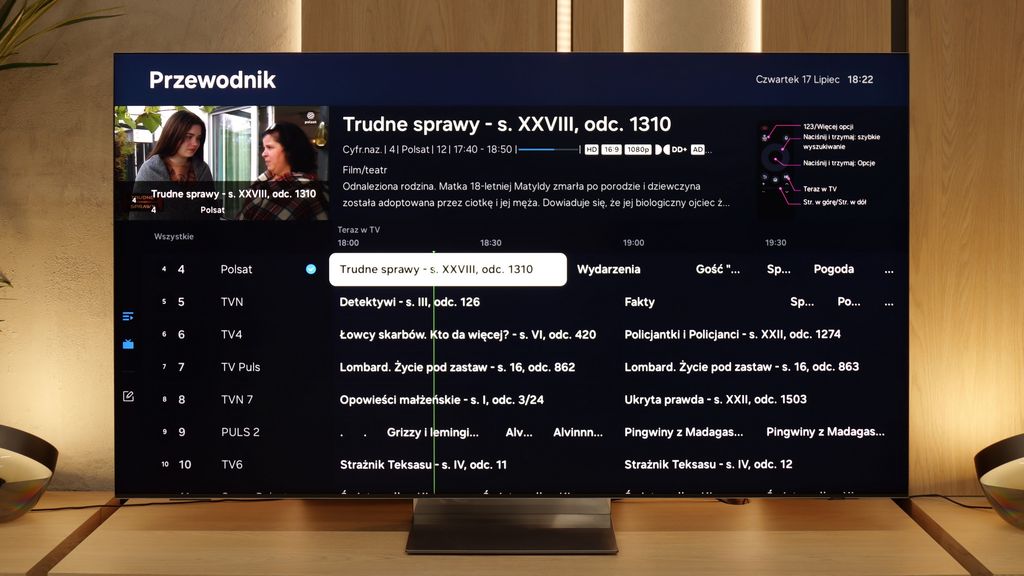
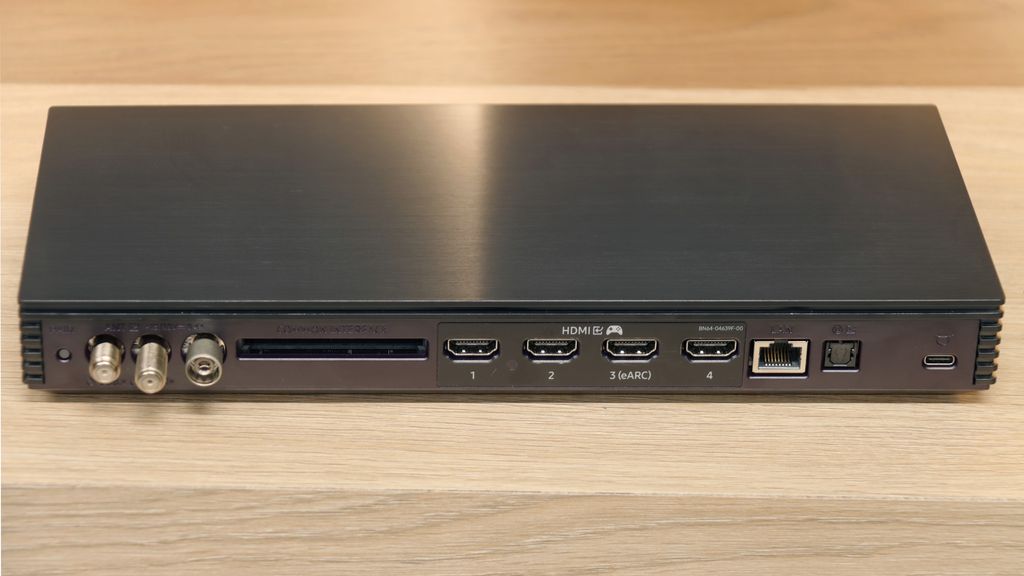
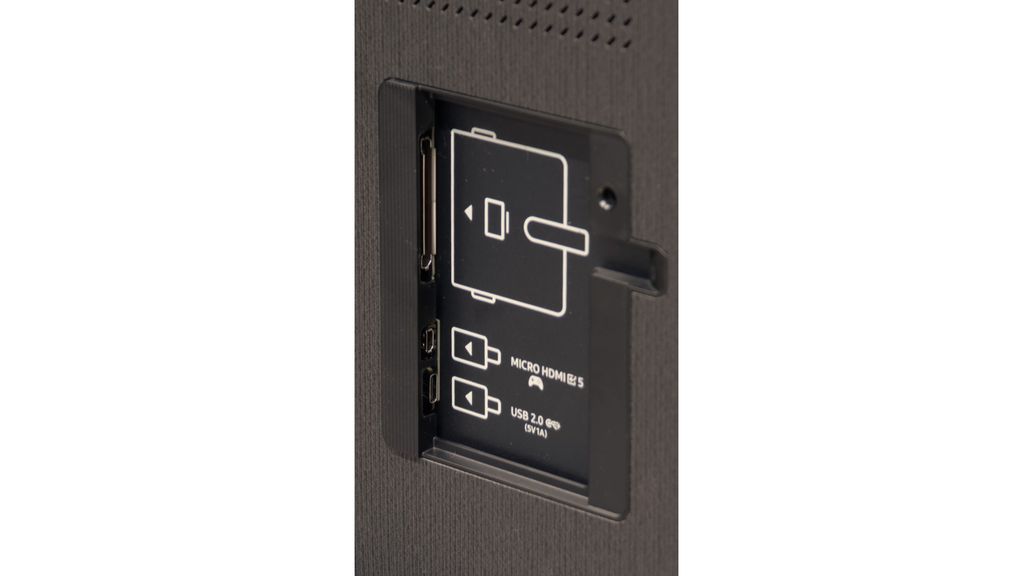
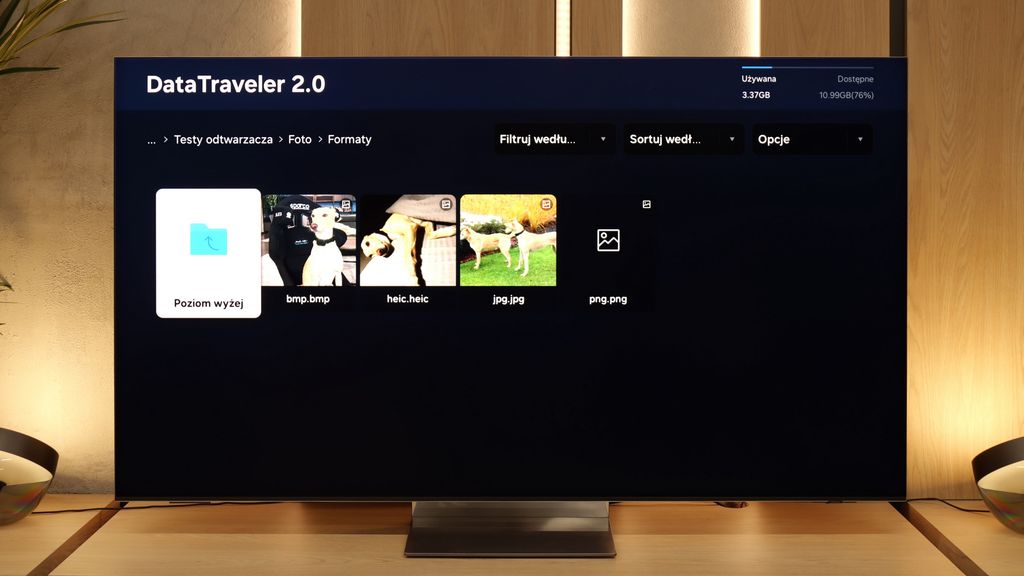
- Regulacja podstawy: stand-Fixed
- Montaż na płasko: Yes
- Akcesoria: accessories-Stand, accessories-OneConnect Box
The Samsung QN990F immediately shows that it is equipment from a different league. Upon taking it out of the box, it is clear that we are dealing with a television meticulously refined in every detail. The entire form is ultra-slim, and the bezels are so narrow that we hardly notice them. It looks truly modern and gives the impression of something exceptional. However, the most impressive aspect is the way Samsung has addressed the issue of connections. The package includes two modules. The first – a classic One Connect, with a silver cable that serves as a receiver. The second – is something completely new: a wireless module to which we connect all the cables. The only exception is an additional micro HDMI, cleverly hidden at the back of the casing. To be honest, we feel that this is somewhat of a missed opportunity – if only the power cable could be left, it would be the first entirely wireless television in the world. But even so, the effect is astounding and leaves a huge impression, especially on those who enjoy technological innovations. We also cannot overlook the stand. It is massive and stable, while at the same time looking light and modern. The rear panel made of glass gives the impression that the television is floating above the table, rather than standing on it. It is a small detail, but precisely the kind that builds the feeling that we are interacting with super premium equipment. It is hard to find someone who would not appreciate the appearance of the QN990F. It is one of those televisions that captures attention even before you manage to turn it on.
Buy in the best price
Select size:
SAMSUNG QN990F - Contrast and black detail
7.6/10
Local dimming function: Yes, number of zones: 1344 (28 x 48)

Result
∞:1

Result
89,250:1

Result
28,200:1

Result
12,100:1

Result
2,050:1
Visibility of details in the lights:

QN990F is the highest representative of the Neo QLED series, so it must include Mini-LED technology. The 65-inch model we tested features a VA panel and an impressive 1344 local dimming zones, which already looks really impressive on paper. In practice, this can achieve a contrast effect close to ideal. In less demanding scenes, such as in the film Oblivion, the QN990F performed on par with OLED televisions – the blacks were virtually infinite, and the picture looked stunning. However, it wasn't always so rosy. Or perhaps black and white? Like every Mini-LED, the QN990F has its limitations, and in more challenging sequences, it can leave mixed impressions. In areas where a huge amount of fine detail appears on the screen, the algorithms controlling the zones simply get confused. The contrast dropped, and a noticeable halo effect appeared around bright elements. Additionally, in films recorded in the 21:9 (2.35:1) format, we noticed that the QN990F was unable to perfectly dim the truly black letterbox bars, leaving a silver/blue glow on them. One could say that Samsung in this model focused more on detail visibility than on achieving perfect black depth. On one hand, this yields very good results in several scenes, on the other – in a television of this class, we expected the local dimming feature to be even better refined. The final effect is simply "okay," and at this price point, we would expect something more than a satisfactory outcome.
Halo effect and black detail visibility:
SAMSUNG QN990F - HDR effect quality
6.6/10
Supported formats: HDR10, HDR10+, HLG Color gamut coverage: DCI P3: 91.1%, Bt.2020: 67.0%
Luminance measurements in HDR:

Result
802 nit

Result
689 nit

Result
1076 nit

Result
577 nit

Result
735 nit
The Samsung QN990F belongs to the bright televisions category, and this is immediately evident in tests. In measurements, it achieved around 1300 nits, which in practice allows for enjoying films as their creators intended. Bright scenes have the right intensity, lights shine, and the experience is truly cinematic. In standard test patterns, sequences number 1, 3, and 5 performed best – there, brightness maintained around 800-1000 nits, and the image looked very natural. In more challenging segments, it could drop to around 600 nits, but even so, the level remained sufficient for details to be clearly visible. However, it should be added that in highly contrasting shots, the halo effect returns – the same one we mentioned regarding black levels. Bright elements can leave a halo on dark backgrounds, and this stands out immediately. Since we are dealing with a QLED, the colour palette is expanded, and the colours appear striking. The problem is that with such a flagship model, we expected better numbers. 91% DCI-P3 coverage and about 67% BT.2020 are results that can be considered solid, but not outstanding. This gives a vibrant and appealing image, yet the competition in this and lower price tiers can showcase even more.
Scene from the movie “Pan” (about 2800 nits)

Scene from the movie “Billy Lynn” (about 1100 nits)

Testing the QN990F with the most demanding films, we received an image that could amaze, but at times left us feeling a bit unsatisfied. In film scenes, a lot of detail was extracted from the shadows, although it was noticeable that the darker elements were slightly boosted. This was even more apparent in Billy Lynn, where the image occasionally looked as if the television was not using local dimming at all – the blacks were significantly brightened, and the brightest parts were washed out. In Blade Runner, the effect was better, but the dark elements still appeared shallow, as if the contrast was limited to very low values, as was the case when we examined the contrast. However, the QN990F handles bright scenes without any problems. The tone mapping works really well, and in the film The Meg, the television performed excellently – especially in the opening shots with rocks and the drilling platform. Here, there was no visible artificial boosting of the dark elements, and the image looked very natural, even compared to a reference OLED. Likewise, the Man performed well, though the HDR effect in sunlight was not as impactful. The colours in general appear attractive, but certain limitations are evident. The skin tones of the characters and some shots can slightly lean towards red, and with the most intense colours, there are shortcomings in saturation.
HDR luminance chart:
Luminancja HDR
Luminance of RGB colors
One of the issues you might encounter with the QN990F is the way it handles details. When using HDR10, sometimes it’s noticeable that the television doesn’t fully grasp the brightest or darkest parts on the screen. A good example is the test card with horses – in HDR10, there were noticeably fewer details, and the whole image looked less natural than it should have. Fortunately, Samsung supports dynamic metadata in the HDR10+ format. Thanks to this dynamic format, the television adjusts to each scene individually, and the image immediately gains in detail. This is particularly evident where the contrasts are greatest – details do not get lost, and everything looks closer to what the director actually wanted to show. Of course, one might regret that Dolby Vision is missing here, which is the most popular dynamic HDR format. On the other hand, HDR10+ is gaining more and more popularity year by year. Movies in this format are no longer a novelty but are becoming something you can find even on Netflix, which significantly changes the situation.
Static HDR10

Dynamic: HDR10+

Factory color reproduction
7/10
We tested the QN990F in Filmmaker mode, which is the best available right out of the box. Right from the start, we noticed several significant errors. The biggest issue concerned white balance. Due to too little blue, and also improper ratios between red and blue, the image – especially in scenes with a lot of white – appeared too yellow, and at times even orange. On the Color Checker palette, these errors didn't look dramatic as they hovered around a value of 4, but in everyday viewing, especially with strong whites, they were most noticeable. We also observed issues with brightness management – the television struggled to maintain detail in the smallest parts of the image, mainly due to the way it controls the backlighting zones. Fortunately, Samsung offers a lot of room for adjustment when it comes to calibration settings. We know that with the right calibration, much more can be extracted from this screen.
Color reproduction after calibration
8.5/10
After completing the calibration, we managed to bring the white balance back to order and eliminate the previous shortcomings in the shades of blue. As a result, the image no longer looked as if it had a slightly yellowish filter applied – the whites are purer, and the overall presentation is much more natural. We also managed, to some extent, to tame the brightness characteristics in HDR content. The television now handles detail retention in blacks significantly better and does not lose them to the same degree as before. However, when we look at the EOTF curve and the way the QN990F reproduces brightness in films, it is evident that it still tends to accentuate details in dark areas more strongly. This is a characteristic feature of Mini-LED technology and, more specifically, the way it is managed by the QN990F, which is practically impossible to completely eliminate. Despite this, after calibration, the image appears much more natural, mainly due to the correct exposure of white light. The final effect is definitely more pleasant to perceive and closer to what we expect from a flagship television.


SAMSUNG QN990F - Smoothness of tonal transitions
9.2/10
In terms of fluidity in tonal transitions, the QN990F demonstrates class. It's one of the best results we've seen so far. In most scenes, there is no question of visible colour banding or typical stepping – transitions are smooth and natural, and the image appears incredibly coherent. Of course, as with virtually any television, in very dark scenes, some issues with gradation can be spotted. Banding can be noticeable there, but this is a typical phenomenon and should not affect the assessment of the QN990F itself. Against the competition, it looks truly very good, and the viewing experience is simply excellent, with the assurance that nothing will distract us from the image.








Image scaling and smoothness of tonal transitions
6.9/10
Smooth transition function

Image without overscan on the SD signal

The biggest praise for the QN990F should be given for its upscaling. The processor responsible for "lifting" classic television to 8K resolution does quite well. While watching material in 576p signal, we had no illusions that we would suddenly see a miracle in advertising style, where the image magically transforms into crystal-clear 8K. Nevertheless, the end result was surprisingly good; the image looked clean and sharp. It’s just a shame that the television, like most Samsung models, has an overscan issue, slightly cropping the edges of the screen from the left side.
When it comes to image processing, Samsung offers a feature called "noise reduction," which in theory should improve tonal transitions in older materials, where they are usually more visible. Unfortunately, we felt quite disappointed here. The feature performs poorly – it does not handle unwanted stripes and can introduce its own artifacts. On the plus side, the television does not remove film grain when using this feature, but in practice, that is a poor consolation since the noise reduction itself proves to be virtually useless.
SAMSUNG QN990F - Blur and motion smoothness
7.9/10
Maximum refresh rate of the panel: 240Hz
Film motion smoothing option: Yes
Blur reduction option: Yes
BFI function 60Hz: Yes, 60Hz (image flickers)
BFI function 120Hz: Yes, 240Hz (double contours)
Brightness drop with BFI: 76%
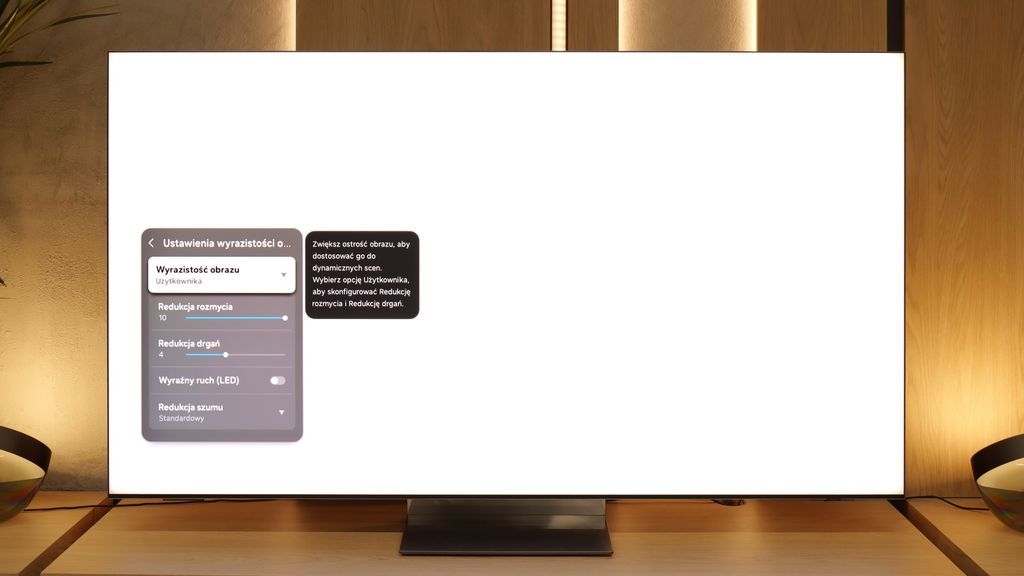
QN990F can comfortably be called one of the fastest televisions in the world. In 4K mode, it is capable of displaying images at a frequency of up to 240 Hz, which until now has been more associated with gaming monitors than with televisions in the living room. However, in everyday viewing, what matters more is how it handles the 8K signal at 120 Hz – and here it performs very well too. Motion remains smooth, and the television manages without a hitch even with the most demanding content. Additionally, there is the motion smoother, i.e. "Picture Clarity". Thanks to it, one can adjust the image to their own preferences – leaving a slightly cinematic judder or switching to maximum fluidity, which works exceptionally well, for example, in sports broadcasts.
Blur (native resolution, maximum refresh rate):



Blur (BFI function enabled):



Smużenie (4K@240Hz):


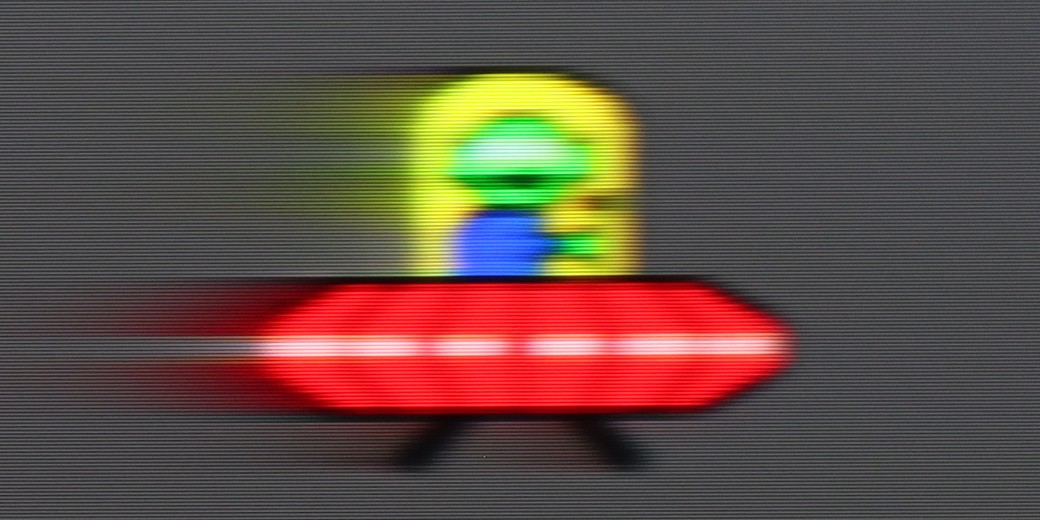
However, the most surprising thing is how the QN990F handles motion blur. In LCD TVs with a VA panel, characteristic smudges are usually visible during fast movements, but here the effect is remarkably minimal. In practice, it looks as if Samsung has managed to come surprisingly close to the level of OLEDs, which have long been regarded as the benchmark in this category.
SAMSUNG QN990F - Console compatibility and gaming features
9.6/10
ALLM: Yes
VRR: Yes
VRR range: 48 - 240Hz
Dolby Vision Game Mode: No
Correct implementation of HGIG: Yes
1080p@120Hz: Yes
1440p@120Hz: Yes
4K@120Hz: Yes
Game bar: Yes
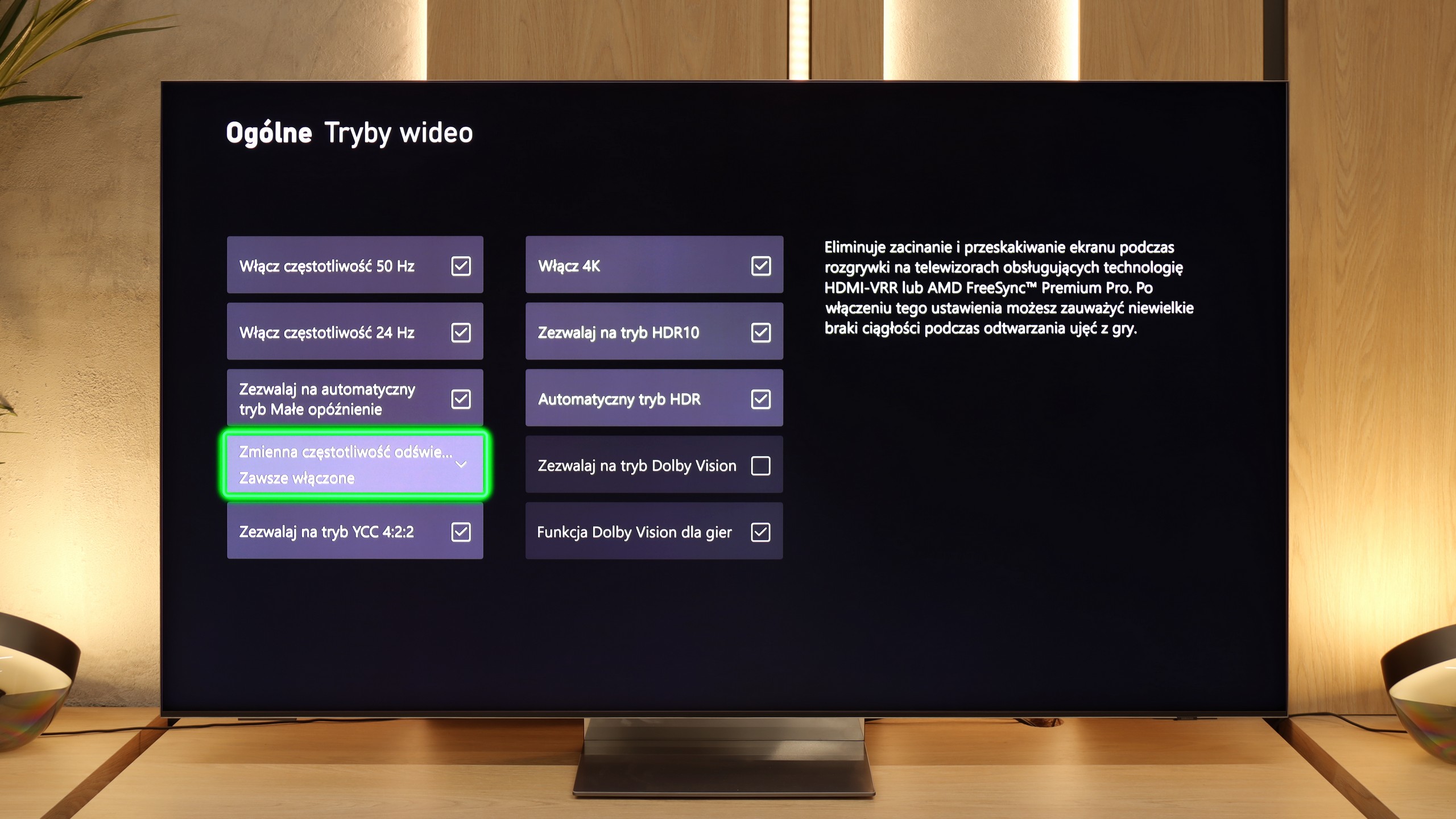
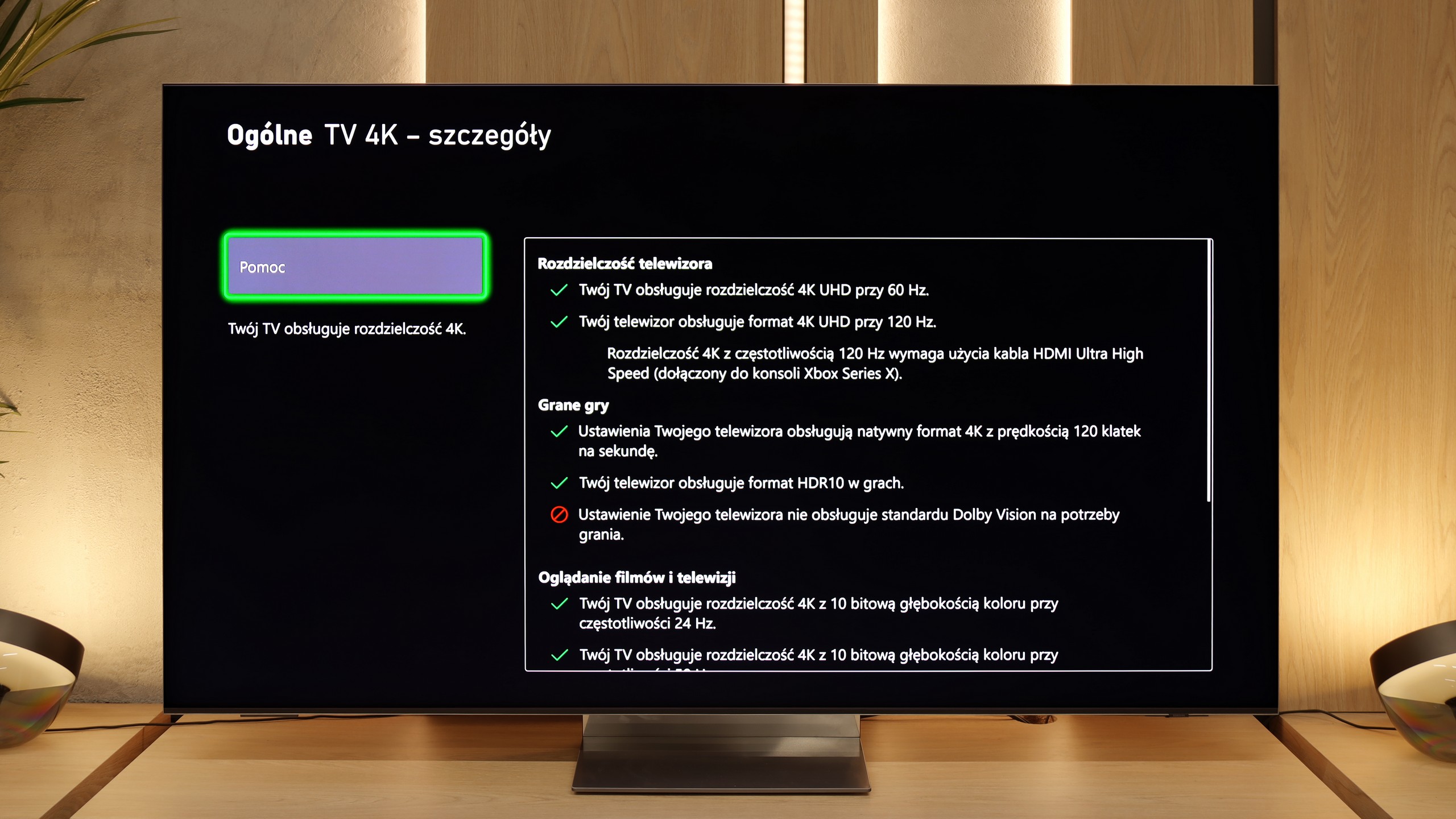
It must be said outright – the QN990F is one of those televisions that practically scream that they were designed with gamers in mind. Samsung has been developing its gaming solutions for years, but here we have a truly comprehensive set. Sure, it lacks Dolby Vision support in games, which is a downside that will always come up in discussions. However, aside from that, the list of features is impressively extensive. To begin with, we have the Game Bar – a handy menu that allows you to quickly check and change gaming-related settings. You can see, for example, the enabled VRR, frame rate, or aspect ratio settings. It’s like a little “dashboard,” making it unnecessary to dig deep into the menu to make adjustments. Speaking of VRR: yes, variable refresh rate is present here and works flawlessly. And there's ALLM, which automatically switches the television to game mode as soon as the console is powered on. These may seem like small details, but together they make using the QN990F simply comfortable and hassle-free.
However, the most impressive aspect is the number of ports. Four wireless HDMI 2.1 ports are already great news, as there is no need to choose whether to connect the console, the amplifier, or perhaps even a PC. There’s ample space for everything here. And if we add another micro HDMI (which we recommend connecting directly to the console), hidden in the casing, we practically have five inputs in full 2.1 standard. Let’s also add support for high refresh rates – 120 Hz at 8K and even 240 Hz at 4K – and we get a television that not only keeps up with the new consoles but also feels ready for consoles that are not yet available.
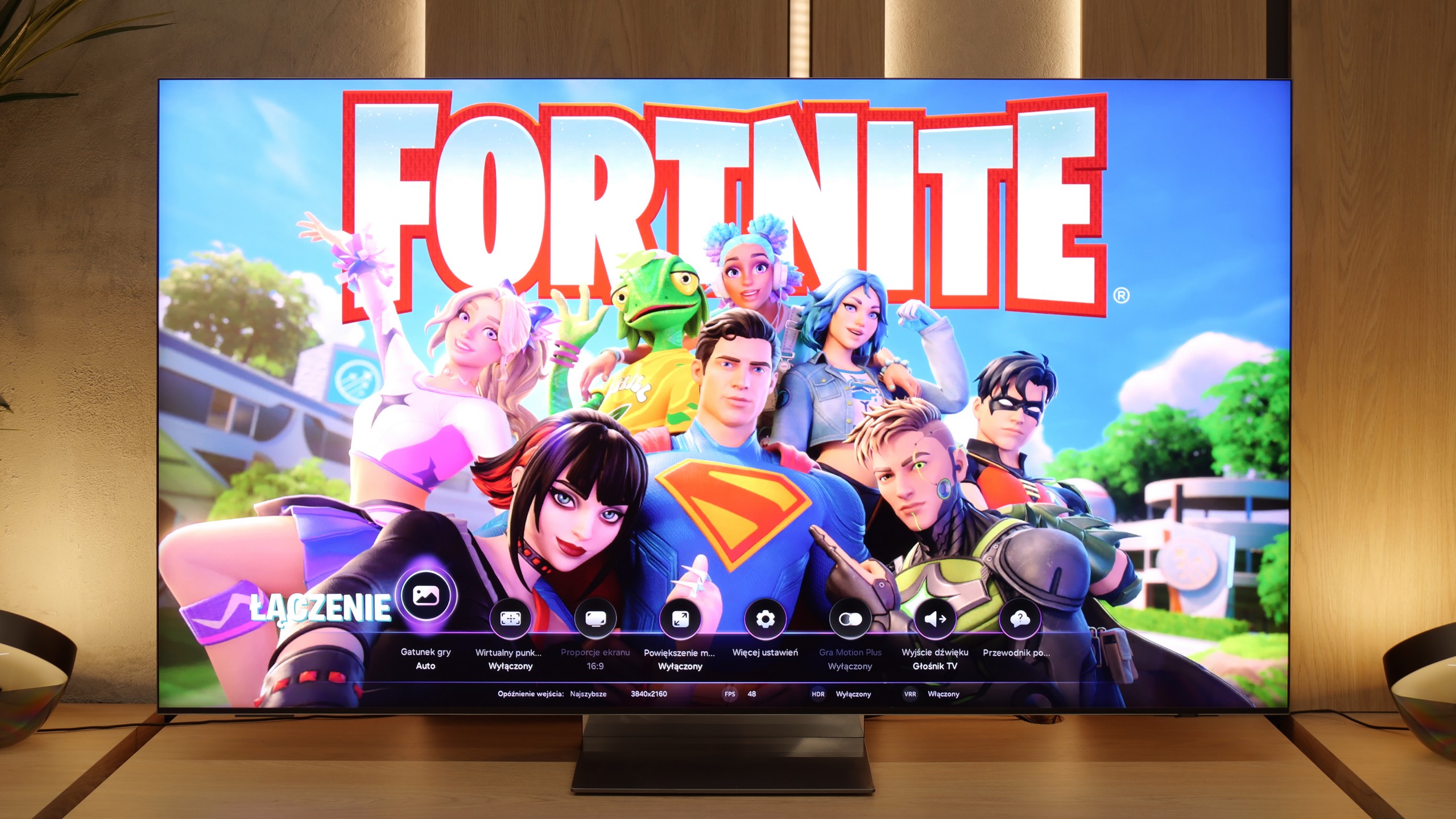
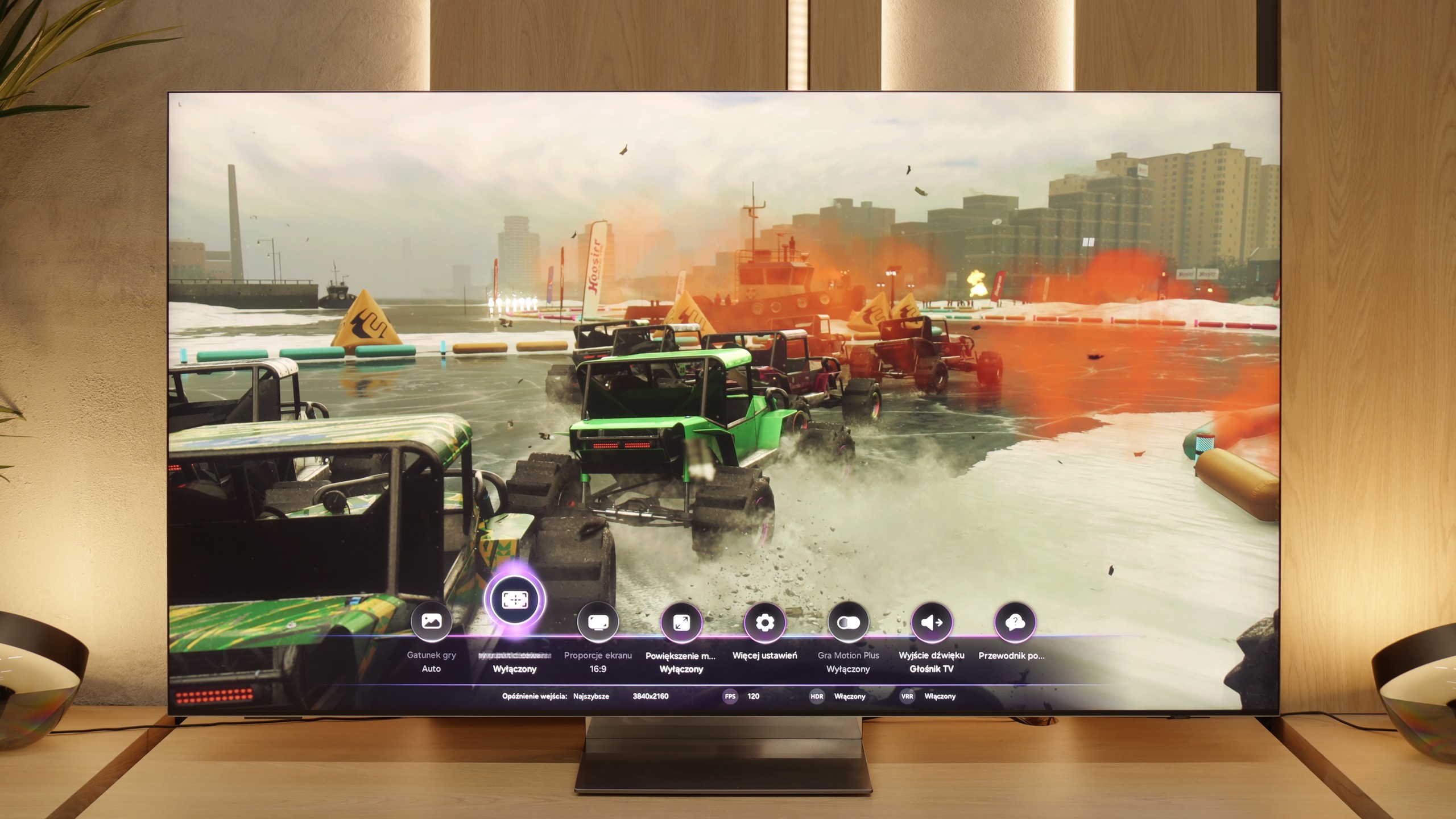

SAMSUNG QN990F - Input lag
9.9/10
If we look at the table with the input lag results, the QN990F performs phenomenally – within 10–15 ms, which is practically at the level of gaming monitors. However, there are a few "buts." First and foremost, the measurements taken on the additional micro HDMI, which Samsung cleverly hid in the television's casing, show the full capabilities. At that point, the image responds instantaneously and gaming is pure pleasure. The problem starts when we connect the console to the wireless One Connect module. Here, the input lag jumps – the measuring device showed values higher by even 20 ms for the first 1–2 seconds before the delays stabilised at around 40 ms. This is a level that can be felt in faster games. Interestingly, the module was positioned next to it, at a distance of 2–3 meters, so the signal did not have any difficult conditions. It's not hard to imagine that if we hide it, for example, behind a sofa at a distance of 6–10 meters, the input lag could exceed even 100-150 ms. And those are values that are already completely unacceptable for gaming.
The input lag measurements for Wireless One Connect from a distance of 2-3m are as follows:
SDR | Input lag | HDR | Input lag |
|---|---|---|---|
1080p60 | 39 ms | ||
1080p120 | 25 ms | ||
2160p60 | 39 ms | 2160p60 | 39 ms |
2160p120 | 26 ms | 2160p120 | 26 ms |
4320p60 | 43 ms | 4320p60 | 43 ms |
| SDR | HDR | Dolby Vision |
|---|---|---|
| 1080p60: 15 ms | 2160p60: 13 ms | |
| 1080p120: 9 ms | 2160p120: 10 ms | |
| 2160p60: 13 ms | 4320p60: 17 ms | |
| 2160p120: 10 ms |

SAMSUNG QN990F - Compatibility with PC
7.9/10
Chroma 444 (maximum resolution and refresh rate): Yes
Font clarity: Average
Readability of dark text and shapes: Average
Input lag in PC mode (4K, maximum refresh rate): 10ms
Matrix subpixel arrangement: BGR
Max refresh rate: 240Hz
G-Sync: Yes
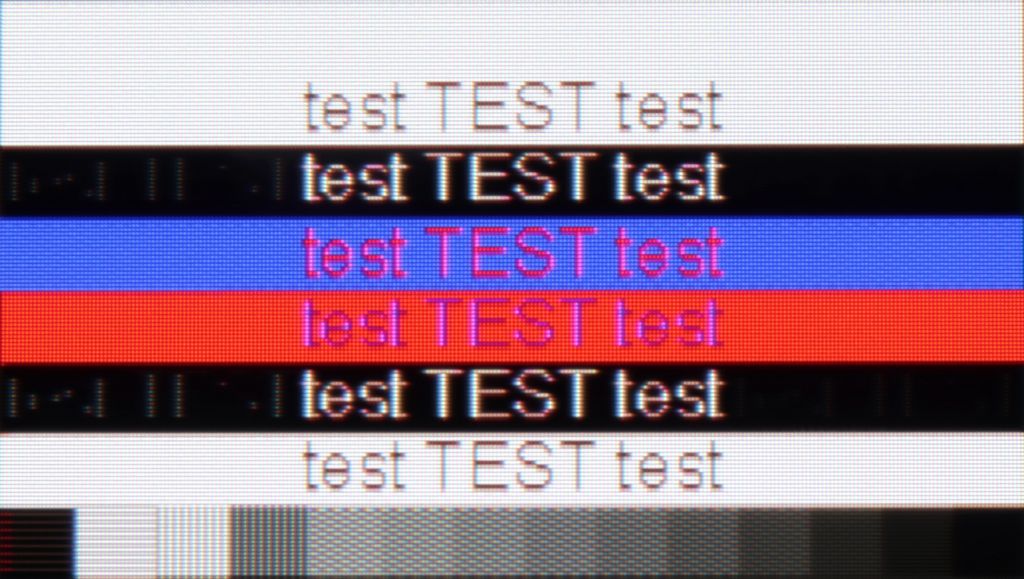
QN990F can impress when we connect a computer to it for gaming. The panel, with a refresh rate of up to 240 Hz, support for G-Sync, and a really decent input lag, makes the television function like a giant gaming monitor. For gaming, this is a dream set-up, and the responsiveness is at a level that is virtually unheard of in regular televisions.
Unfortunately, the situation is significantly poorer when it comes to ordinary PC work. It's a shame because the 8K resolution theoretically has immense potential – you can even place a 65-inch screen on your desk and sit close to it, benefiting from the enormous pixel density. However, in practice, the magic dissipates. Despite proper implementation of chroma 4:4:4, which should guarantee sharp fonts, the readability on the QN990F is not ideal. The letters have slight edge issues, and longer work with text simply isn't comfortable. It's a pity, as gamers have a lot to offer here, and the capabilities in games are excellent. However, this television is rather unsuitable for everyday office work.
SAMSUNG QN990F - Viewing angles
6.5/10
Brightness drop at an angle of 45 degrees: 57%
Samsung has employed a coating in the QN990F that widens the viewing angles, and it does indeed fulfill its purpose. We have the impression that this year it works a bit less effectively than in last year’s models, but nonetheless, the effect is still impressive. For a VA panel, the angles are really very good – to the extent that they can be compared to what is offered by televisions with IPS panels. This means that even when watching from the side, we do not noticeably lose either contrast or colours.
SAMSUNG QN990F - TV efficiency during daytime
5.2/10
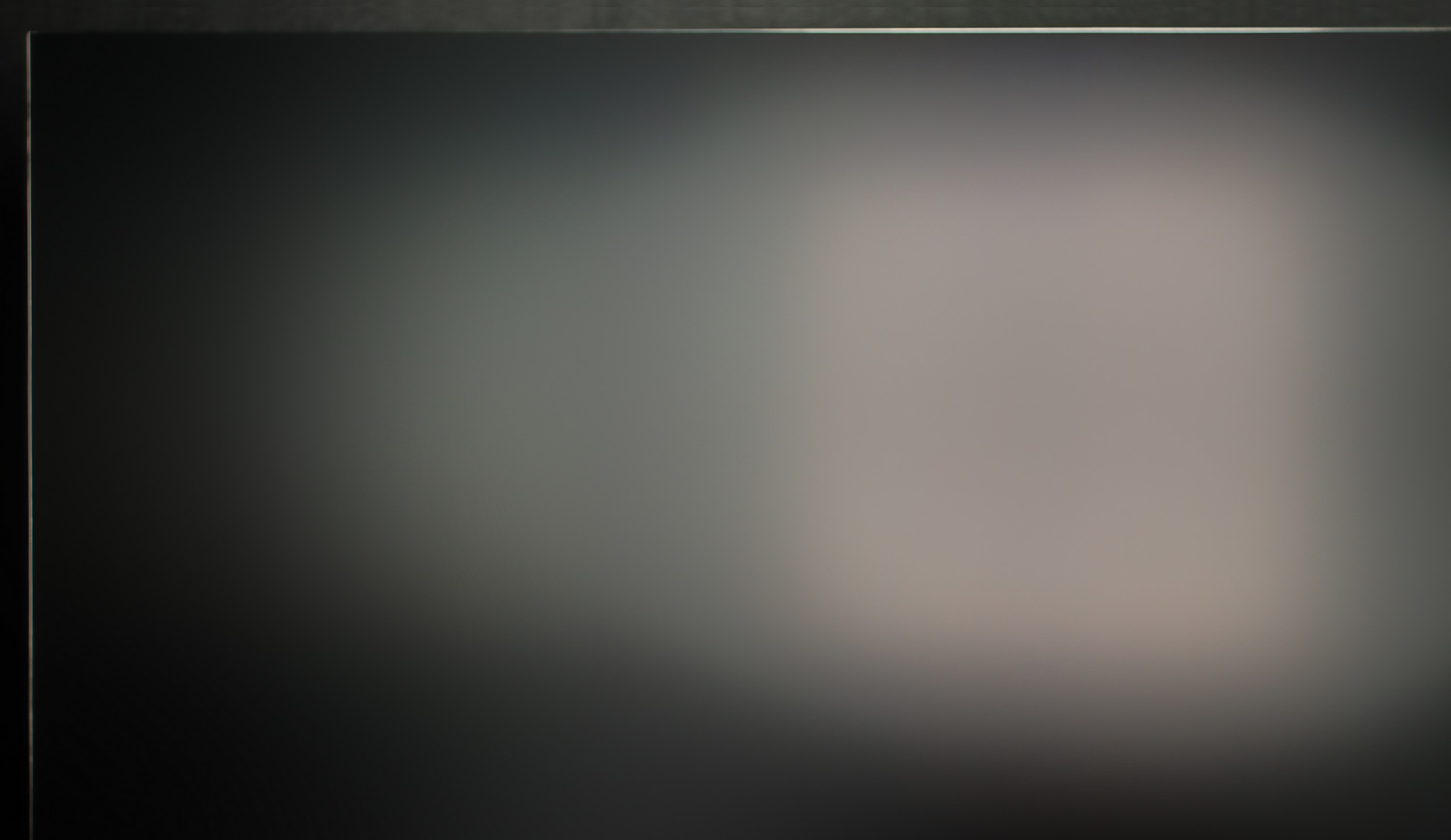

Matrix coating: Matte
Reflection suppression: Very Good
Black levels during daytime: Average
One of the biggest innovations in this year's Neo QLED 8K TVs is the matte screens. Yes, you read that correctly – Samsung has applied a matte finish to its flagship model, and we must admit that the effect is truly impressive. Reflections practically disappear, the screen doesn't turn into a mirror, and watching in a bright living room suddenly becomes much more enjoyable. Of course, there’s no rose without thorns. The matte finish makes blacks appear a bit faded during the day, and colours lose some of their richness. It’s a compromise – either we battle reflections or we retain maximum colour depth.
When it comes to brightness, the QN990F is not a record breaker. In TV mode, it achieves around 370–400 nits, which is fine for everyday television viewing, but may prove insufficient in very bright, sunlit rooms to completely "pierce" through the incoming light.
Matrix brightness
Average luminance SDR
Samsung QN990F: 363 cd/m2
SAMSUNG QN990F - TV features
7.5/10
System: Tizen
System performance: Very Good
- HDMI inputs: 0 x HDMI 2.0, 5 x HDMI 2.1 48Gbps
- Outputs: Toslink (Optical audio), eARC (HDMI), ARC (HDMI)
- Network Interfaces: Wi-Fi 2.4GHz, Wi-Fi 5GHz, Ethernet (LAN) 100Mbps
- TV reception: DVB-T, DVB-T2, DVB-S, DVB-S2, DVB-C
Classic features:
Recording to USB (terrestrial TV): No
Recording programming: No
Picture in Picture (PiP): Yes
RF remote control (no need to aim at the screen): RF
Backlit remote control: No
Teletext: Yes
Audio only mode: Yes
Possibility to connect Bluetooth headphones to the TV: Yes
Possibility to simultaneously use Bluetooth headphones and the TV speaker: Yes
Smart features:
AirPlay: Yes
Screen mirroring (Windows Miracast): Yes
Wyszukiwanie głosowe: Yes
Voice search in native language: Yes
Ability to connect a keyboard and mouse: Yes








Classic Features and Connections
Although the QN990F looks like a television from the future, if someone simply wants to watch regular television – it can be done, and quite comfortably too. It comes with several practical additions, such as PiP, which allows for watching two sources simultaneously. Mentioning Bluetooth is hardly necessary, as it has become a standard. However, particular attention should be given to the whole idea of wireless operation. The One Connect module can be placed in a different location than the television itself, which is a significant convenience for those who frequently switch devices. Of course, it still needs to be plugged in, so it's not completely cable-free, but it's hard not to view this as a demonstration of Samsung's capabilities – a glimpse of how televisions of the future might look.
Smart TV System: Tizen
When it comes to the operating system, Samsung has opted for its proprietary Tizen, which, despite being a closed ecosystem, operates extremely smoothly. It is one of the fastest, if not the fastest, operating systems in televisions, and it is also very intuitive. All the classic smart features are present: AirPlay, screen mirroring, voice search in multiple languages, and quick access to the most important streaming applications. While a few niche programmes may be missing, the vast majority of users will find everything they need here.
SAMSUNG QN990F - Apps
8.7/10























SAMSUNG QN990F - Playing files from USB
9.1/10

| Maximum photo resolution: | Supported photo formats: |
|---|---|
QN990F handles playback of files from USB practically flawlessly. Films, music, photos – most popular formats work without the slightest problems and there is no need to fiddle with additional players or devices. It is only with rarely encountered photo formats that limitations may arise. It is a pity that despite the manufacturer's declarations, there is a lack of proper support for HEIC files. The television sees them in the media browser, but in practice, it cannot open them.
SAMSUNG QN990F - Sound
7.9/10
-
Maximum volume
Supported codecs
(TV speakers)
Dolby Digital Plus 7.1
Dolby True HD 7.1
Dolby Atmos in Dolby Digital Plus (JOC)
Dolby Atmos in Dolby True HD
DTS:X in DTS-HD MA
DTS-HD Master Audio
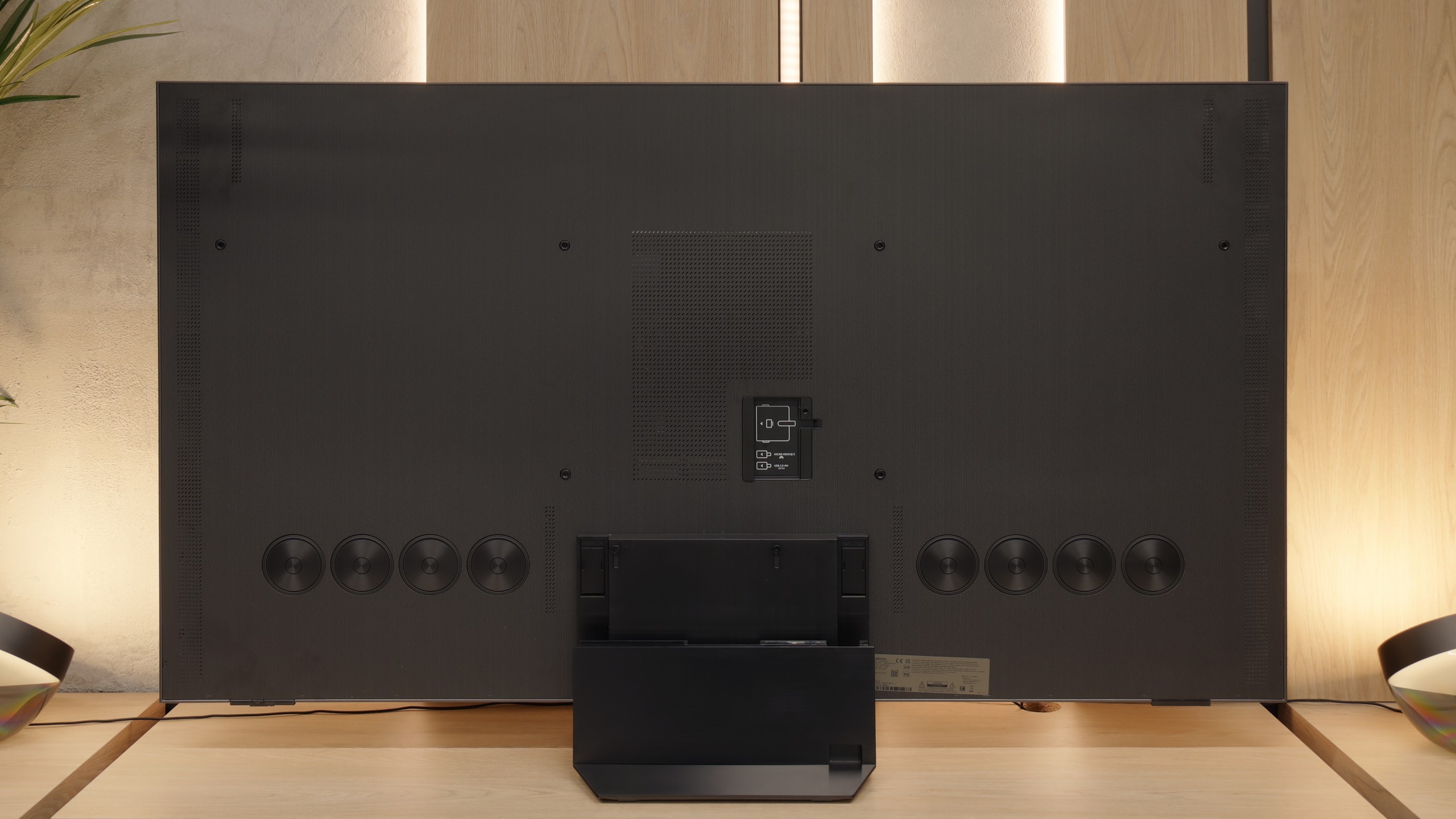
QN990F can play really pleasantly. Considering such a slim design, the sound is surprisingly clear and detailed, so one can be satisfied for everyday movie watching or gaming. Unfortunately, as is often the case with Samsung's ultra-thin TVs, there is a lack of bass – and you can feel it immediately. Action scenes or stronger effects do not have the depth that a decent soundbar or home theatre system would provide. On the positive side, however, it deserves credit for supporting Dolby Atmos. This is currently the most popular spatial audio codec in films and gives a much greater sense of immersion in the action. Unfortunately, as always with Samsung, support for DTS:X is missing. This format is indeed appearing less frequently in new productions, but it is still valued by fans of physical Blu-ray media.
Acoustic Measurements
No acoustic data
SAMSUNG QN990F - Details about the matrix
Software version during testing: T-RSPFDEUC-0090-1050.6 E2500007, BT-S
Panel uniformity:

Backlight Type: Mini-LED QLED

Founder and originator of the "ChooseTV" portal

Journalist, reviewer, and columnist for the "ChooseTV" portal
See articles related to Samsung QN990F:
4/3/2025
Our channel Youtube
Intelligent calibration of Samsung TV in SmartThings 6/23/2025
Shopping Reviews
The best Samsung televisions 2024 / 2025! Which Samsung tele... 4/30/2025











